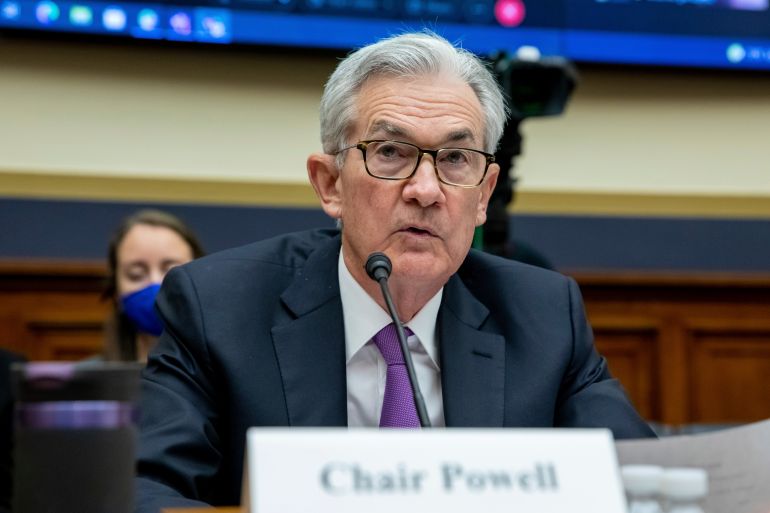Inflation is the buzzword at US Fed chief’s confirmation hearing
Fed chief Jerome Powell is grilled over inflation at his Senate confirmation hearing.

Federal Reserve Chairman Jerome Powell received a grilling over inflation during a Senate hearing on Tuesday to confirm him for a second term as the United States’ top central banker.
In prepared remarks, Powell acknowledged how soaring inflation is squeezing US households, particularly low-income ones that are seeing a larger slice of their incomes eroded by rising price pressures.
Keep reading
list of 4 items‘We need you’: Solomon Islands’ support for US agency’s return revealed
Why are nations racing to buy weapons?
Parallel economy: How Russia is defying the West’s boycott
“We know that high inflation exacts a toll, particularly for those less able to meet the higher costs of essentials like food, housing and transportation,” he said.
President Joe Biden in November tapped Powell to serve a second four-year term at the helm of the Fed. During his first term, Powell stewarded the economy through the nation’s fastest and deepest economic dive on record during the opening months of the coronavirus pandemic back in 2020. He has presided over a recovery since then that has seen prices soar thanks to supply-chain bottlenecks and shortages of raw materials and workers.
Throughout most of the recovery, the Fed has kept borrowing costs at historic lows, regarding price pressures as “transitory” as it prioritised getting the millions of Americans who had lost their jobs to the pandemic’s initial round of lockdowns back to work.
But in December, with inflation running at its hottest rate in nearly 40 years and the labour market awash in a near-record number of job openings, Powell retired the word “transitory” in testimony before Congress.
Later that month, at the conclusion of the Fed’s final policy-setting meeting of 2021, the central bank took a hawkish shift towards containing inflation, saying that it would speed up its unwinding of bond purchases that have helped keep long-term interest rates low, and signalling that at least three price-cooling interest rate hikes could be in the cards this year.
Since then, minutes from the December Fed policy-setting meeting released last week raised the spectre of a rate hike happening as soon as March.
And some economists are calling for even more aggressive Fed action.
In a note to clients on Sunday, Goldman Sachs economists led by Jan Hatzius said they now see four interest rate hikes happening this year.
“We continue to see hikes in March, June, and September, and have now added a hike in December for a total of four in 2022,” they wrote.
On Tuesday, Powell treated senators to a lesson in supply and demand, and how the imbalance between the two is fuelling inflation.
“We have very strong demand in areas where supply is constrained, particularly around goods, particularly around things like cars,” he explained.
Powell said he and his fellow policymakers think there will be a return to normal supply conditions over the course of the year, but he also reassured senators that if the Fed sees “inflation persisting at high levels longer than expected”, it will take action.
“If we have to raise interest rates more over time, we will,” he said, adding that “high inflation is a severe threat to the achievement of maximum employment and to achieving a long expansion that can give us that.”
The US economy added a disappointing 199,000 jobs in December, but the nation’s unemployment rate edged down to 3.9 percent as it closes in on its pre-pandemic level of 3.5 percent.
A near-record number of job openings has led businesses to sweeten pay and benefits packages to lure scare job seekers. In a measure of how confident workers feel about their employment prospects, they are quitting their jobs in record numbers – often to take higher-paying positions.
That’s reflected in average hourly earnings for all workers, which increased 4.7 percent in December from the same period a year ago.
But soaring inflation is eating into the purchasing power of US households. The Federal Reserve’s preferred gauge of underlying inflation, personal consumption expenditures, surged 5.7 percent in November compared with a year earlier – the sharpest spike in nearly 40 years.